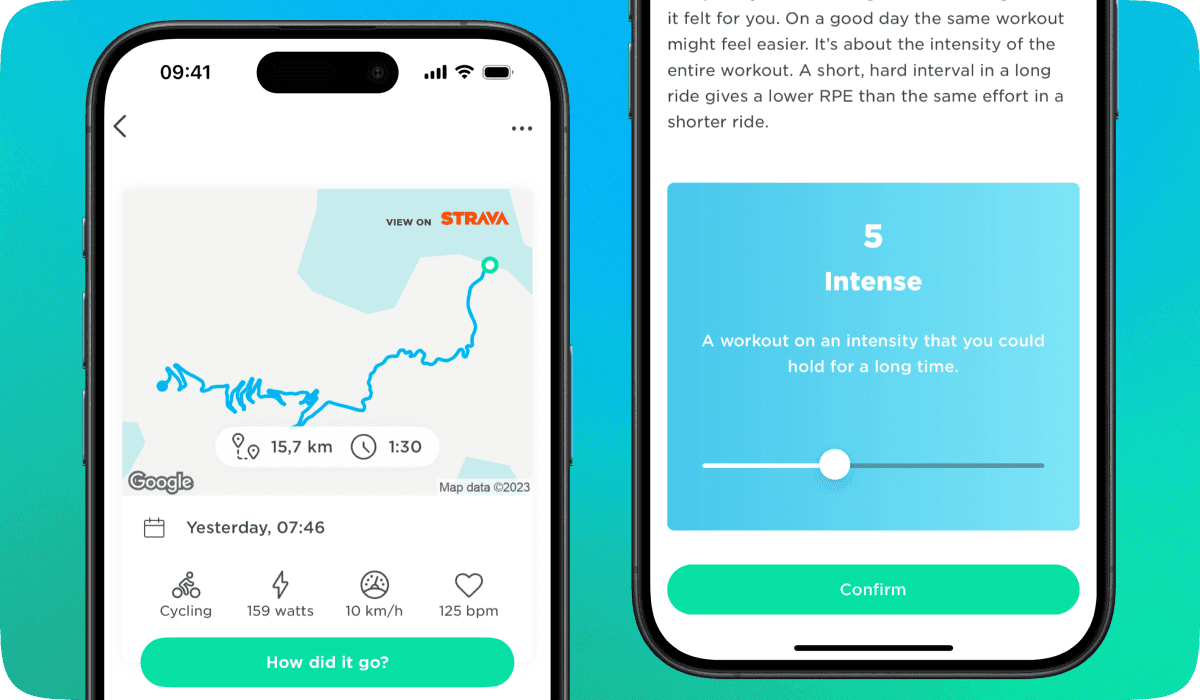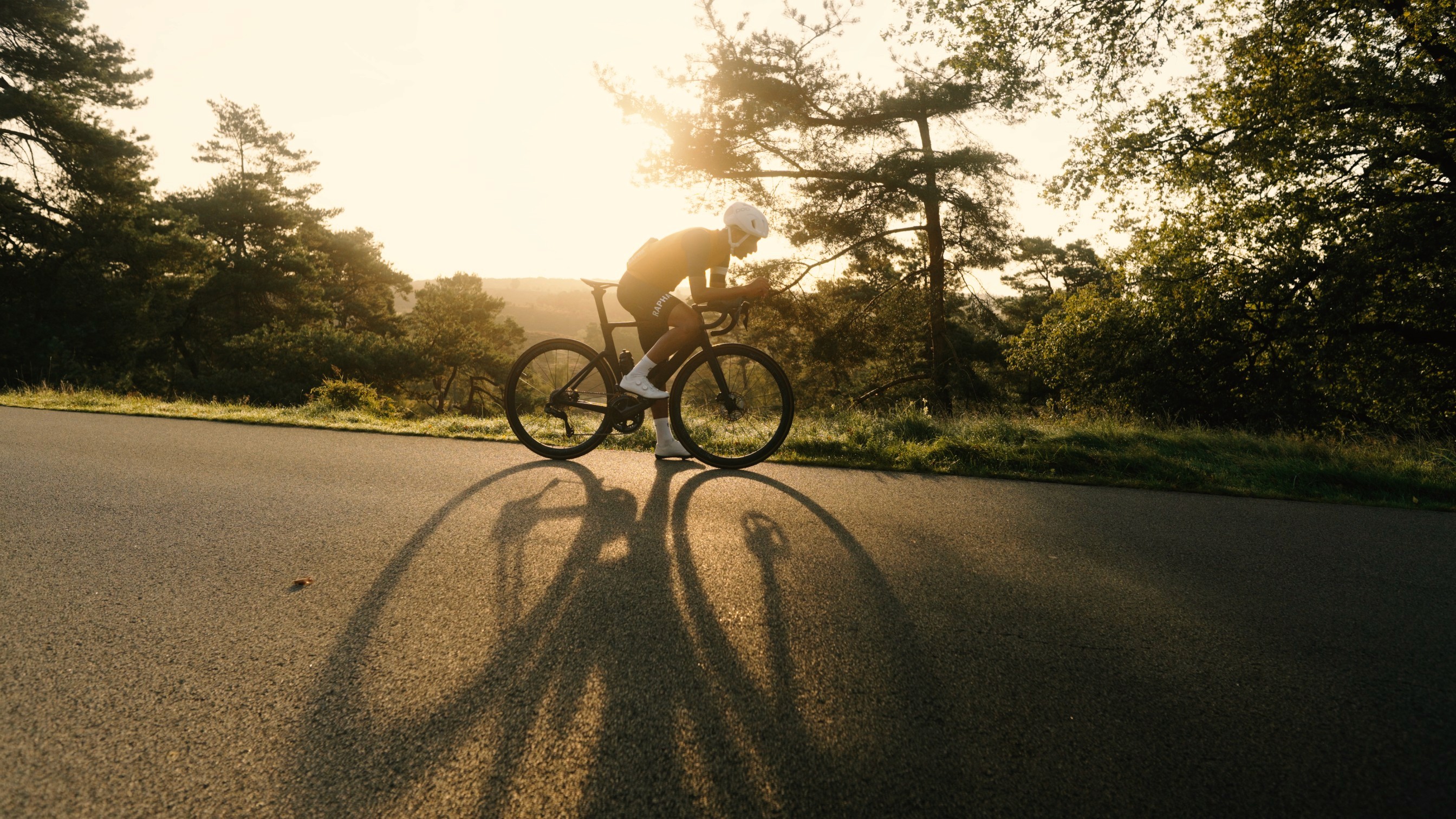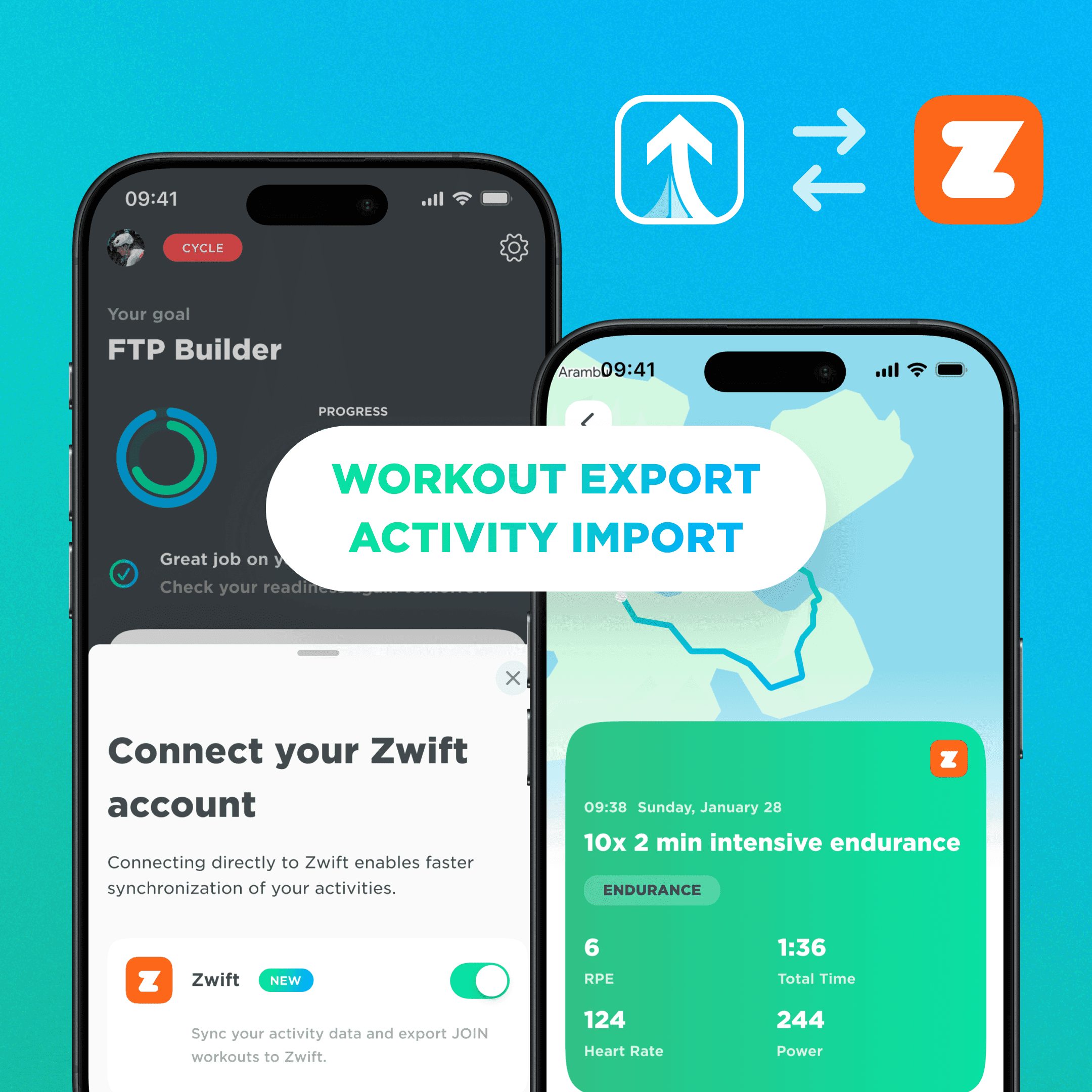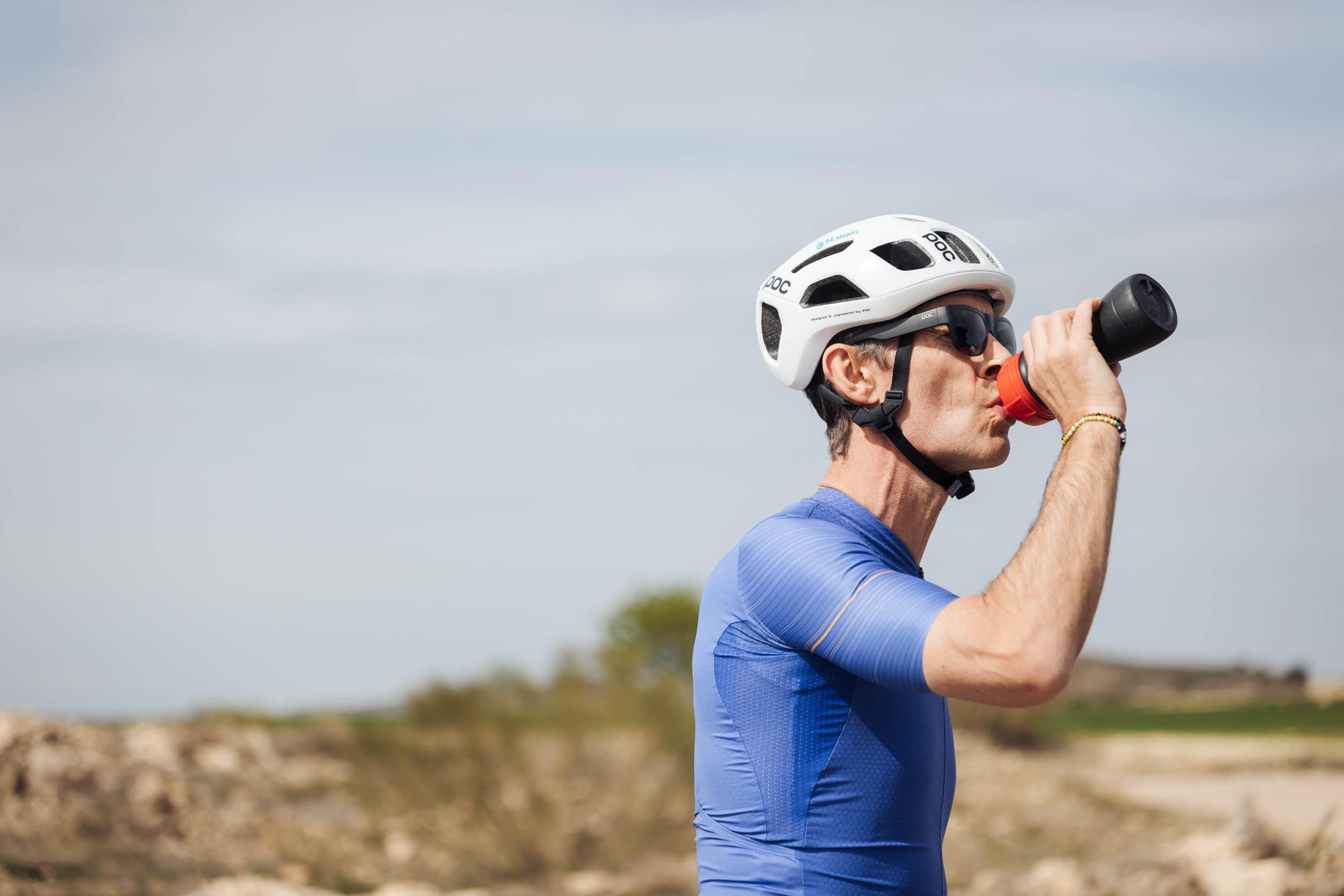The Importance of RPE in Cycling

Nov 7, 2024

The Importance of RPE in Cycling
Nov 7, 2024

The Importance of RPE in Cycling

Nov 7, 2024

When it comes to cycling performance, data-driven insights are critical. Power meters, heart rate monitors, and advanced algorithms are all part of modern training, but there’s one tool that’s as old as training itself: the Rate of Perceived Exertion (RPE). While it may seem basic compared to the technological gadgets many cyclists use today, RPE remains one of the most effective ways to assess workout intensity. In fact, within the JOIN app, RPE is not just a feature but a cornerstone of our adaptive training approach.
What is RPE and Why Does It Matter?
RPE is a scale that athletes use to rate how hard they feel they’re working during or after exercise. Typically rated on a scale from 1/2 to 10 or 4 to 20, RPE allows athletes to assess the internal load on their body during a workout. Unlike external data, like power output, which tells you how much work you’re doing, RPE gauges how your body feels in response to that workload. It is the bridge between your external performance metrics and how your body is actually coping with the effort.Despite the rise of high-tech measurement tools, RPE remains one of the most valuable and accurate methods for assessing intensity, especially when combined with external data like power meter readings. Why? Because your perceived effort often tells a more complete story than numbers alone.
The Oldest and Still One of the Best Methods
RPE is the oldest way athletes have gauged their intensity. Before the invention of heart rate monitors and power meters, athletes relied solely on how they felt to manage their training. But don’t be fooled into thinking it’s an outdated method. On the contrary, it’s an essential component of any effective training program, and its simplicity hides its true sophistication.
Your power meter might tell you that you’re pushing 250 watts, but how does your body feel while doing that? Were you able to maintain that effort easily, or did you struggle? Some days, external metrics like power may suggest you’re performing well, but your perceived effort could be much higher, indicating fatigue, stress, or other factors that affect your body’s internal load.
Inconsistent training, on the other hand, leads to plateaus, frustration, and even injury. Your body needs steady stress to adapt, recover, and improve. By integrating cycling into your routine as a habit, you ensure that you’re logging those necessary hours in the saddle that will ultimately pay off in your performance.

Why RPE is Crucial in JOIN’s Adaptive Approach
At JOIN, we combine both external load (from metrics like power data) and internal load (from RPE) to get a complete picture of your workout intensity. After every workout, the app asks how you would rate the intensity of the session on a scale of 2 to 10. This information allows JOIN to adapt your training plan more effectively, considering both the physical output and how your body perceived the effort.This combination of data makes your training not just flexible but truly adaptive. It’s not just about how much work you’re doing; it’s also about how your body is responding to that workload. RPE helps fine-tune your training by allowing the app to adjust based on your internal feedback. This ensures your plan remains optimal, even on days when external metrics might not tell the whole story.
The Art of Checking In With Your Body
Filling in your RPE within one hour of finishing your workout is key. The closer you are to the workout, the more accurate your perception of effort will be. Don’t overthink it. Just ask yourself: how hard did it feel? Was it a 5, a 7, or a 9 out of 10? The more frequently you engage with your RPE, the better you’ll become at interpreting your body’s feedback.For many athletes, this skill doesn’t come naturally at first. But like any skill, you’ll improve over time. Learning to assess your psychosomatic feedback—your body’s emotional and physical reactions to training—will make you a better, more intuitive athlete..
Why RPE Matters Beyond the Workout
Being more in check with your body isn’t just useful after a ride; it’s a critical tool during all phases of your training:
Before the ride: Checking in with your body can help you decide whether to stick to your plan or adjust it. For instance, if you wake up feeling particularly fatigued, you might opt to scale back the intensity or skip a session.
During the ride: Interpreting better how it feels lets you monitor your internal load in real time. You might feel strong enough to push harder during intervals or know when it’s time to ease off.
After the ride: Providing accurate RPE feedback helps JOIN adjust your future training. If a workout felt harder than expected, the app can recalibrate your upcoming sessions accordingly.
Develop Your Skill to Better Understand Your Body
Mastering the interpretation of RPE isn’t just about getting through your workouts; it’s about developing an essential skill that will help you manage your training and recovery more effectively. The ability to understand how your body feels, and why it feels that way, is a powerful asset. It helps you prevent burnout, overtraining, and injuries while also allowing you to optimize performance gains.So, next time JOIN asks for your RPE after a workout, remember that this feedback is integral to your long-term success. By combining RPE with power data, you’re not just training smarter—you’re training more holistically, and that’s where real progress happens.
When it comes to cycling performance, data-driven insights are critical. Power meters, heart rate monitors, and advanced algorithms are all part of modern training, but there’s one tool that’s as old as training itself: the Rate of Perceived Exertion (RPE). While it may seem basic compared to the technological gadgets many cyclists use today, RPE remains one of the most effective ways to assess workout intensity. In fact, within the JOIN app, RPE is not just a feature but a cornerstone of our adaptive training approach.
What is RPE and Why Does It Matter?
RPE is a scale that athletes use to rate how hard they feel they’re working during or after exercise. Typically rated on a scale from 1/2 to 10 or 4 to 20, RPE allows athletes to assess the internal load on their body during a workout. Unlike external data, like power output, which tells you how much work you’re doing, RPE gauges how your body feels in response to that workload. It is the bridge between your external performance metrics and how your body is actually coping with the effort.Despite the rise of high-tech measurement tools, RPE remains one of the most valuable and accurate methods for assessing intensity, especially when combined with external data like power meter readings. Why? Because your perceived effort often tells a more complete story than numbers alone.
The Oldest and Still One of the Best Methods
RPE is the oldest way athletes have gauged their intensity. Before the invention of heart rate monitors and power meters, athletes relied solely on how they felt to manage their training. But don’t be fooled into thinking it’s an outdated method. On the contrary, it’s an essential component of any effective training program, and its simplicity hides its true sophistication.
Your power meter might tell you that you’re pushing 250 watts, but how does your body feel while doing that? Were you able to maintain that effort easily, or did you struggle? Some days, external metrics like power may suggest you’re performing well, but your perceived effort could be much higher, indicating fatigue, stress, or other factors that affect your body’s internal load.
Inconsistent training, on the other hand, leads to plateaus, frustration, and even injury. Your body needs steady stress to adapt, recover, and improve. By integrating cycling into your routine as a habit, you ensure that you’re logging those necessary hours in the saddle that will ultimately pay off in your performance.

Why RPE is Crucial in JOIN’s Adaptive Approach
At JOIN, we combine both external load (from metrics like power data) and internal load (from RPE) to get a complete picture of your workout intensity. After every workout, the app asks how you would rate the intensity of the session on a scale of 2 to 10. This information allows JOIN to adapt your training plan more effectively, considering both the physical output and how your body perceived the effort.This combination of data makes your training not just flexible but truly adaptive. It’s not just about how much work you’re doing; it’s also about how your body is responding to that workload. RPE helps fine-tune your training by allowing the app to adjust based on your internal feedback. This ensures your plan remains optimal, even on days when external metrics might not tell the whole story.
The Art of Checking In With Your Body
Filling in your RPE within one hour of finishing your workout is key. The closer you are to the workout, the more accurate your perception of effort will be. Don’t overthink it. Just ask yourself: how hard did it feel? Was it a 5, a 7, or a 9 out of 10? The more frequently you engage with your RPE, the better you’ll become at interpreting your body’s feedback.For many athletes, this skill doesn’t come naturally at first. But like any skill, you’ll improve over time. Learning to assess your psychosomatic feedback—your body’s emotional and physical reactions to training—will make you a better, more intuitive athlete..
Why RPE Matters Beyond the Workout
Being more in check with your body isn’t just useful after a ride; it’s a critical tool during all phases of your training:
Before the ride: Checking in with your body can help you decide whether to stick to your plan or adjust it. For instance, if you wake up feeling particularly fatigued, you might opt to scale back the intensity or skip a session.
During the ride: Interpreting better how it feels lets you monitor your internal load in real time. You might feel strong enough to push harder during intervals or know when it’s time to ease off.
After the ride: Providing accurate RPE feedback helps JOIN adjust your future training. If a workout felt harder than expected, the app can recalibrate your upcoming sessions accordingly.
Develop Your Skill to Better Understand Your Body
Mastering the interpretation of RPE isn’t just about getting through your workouts; it’s about developing an essential skill that will help you manage your training and recovery more effectively. The ability to understand how your body feels, and why it feels that way, is a powerful asset. It helps you prevent burnout, overtraining, and injuries while also allowing you to optimize performance gains.So, next time JOIN asks for your RPE after a workout, remember that this feedback is integral to your long-term success. By combining RPE with power data, you’re not just training smarter—you’re training more holistically, and that’s where real progress happens.
When it comes to cycling performance, data-driven insights are critical. Power meters, heart rate monitors, and advanced algorithms are all part of modern training, but there’s one tool that’s as old as training itself: the Rate of Perceived Exertion (RPE). While it may seem basic compared to the technological gadgets many cyclists use today, RPE remains one of the most effective ways to assess workout intensity. In fact, within the JOIN app, RPE is not just a feature but a cornerstone of our adaptive training approach.
What is RPE and Why Does It Matter?
RPE is a scale that athletes use to rate how hard they feel they’re working during or after exercise. Typically rated on a scale from 1/2 to 10 or 4 to 20, RPE allows athletes to assess the internal load on their body during a workout. Unlike external data, like power output, which tells you how much work you’re doing, RPE gauges how your body feels in response to that workload. It is the bridge between your external performance metrics and how your body is actually coping with the effort.Despite the rise of high-tech measurement tools, RPE remains one of the most valuable and accurate methods for assessing intensity, especially when combined with external data like power meter readings. Why? Because your perceived effort often tells a more complete story than numbers alone.
The Oldest and Still One of the Best Methods
RPE is the oldest way athletes have gauged their intensity. Before the invention of heart rate monitors and power meters, athletes relied solely on how they felt to manage their training. But don’t be fooled into thinking it’s an outdated method. On the contrary, it’s an essential component of any effective training program, and its simplicity hides its true sophistication.
Your power meter might tell you that you’re pushing 250 watts, but how does your body feel while doing that? Were you able to maintain that effort easily, or did you struggle? Some days, external metrics like power may suggest you’re performing well, but your perceived effort could be much higher, indicating fatigue, stress, or other factors that affect your body’s internal load.
Inconsistent training, on the other hand, leads to plateaus, frustration, and even injury. Your body needs steady stress to adapt, recover, and improve. By integrating cycling into your routine as a habit, you ensure that you’re logging those necessary hours in the saddle that will ultimately pay off in your performance.

Why RPE is Crucial in JOIN’s Adaptive Approach
At JOIN, we combine both external load (from metrics like power data) and internal load (from RPE) to get a complete picture of your workout intensity. After every workout, the app asks how you would rate the intensity of the session on a scale of 2 to 10. This information allows JOIN to adapt your training plan more effectively, considering both the physical output and how your body perceived the effort.This combination of data makes your training not just flexible but truly adaptive. It’s not just about how much work you’re doing; it’s also about how your body is responding to that workload. RPE helps fine-tune your training by allowing the app to adjust based on your internal feedback. This ensures your plan remains optimal, even on days when external metrics might not tell the whole story.
The Art of Checking In With Your Body
Filling in your RPE within one hour of finishing your workout is key. The closer you are to the workout, the more accurate your perception of effort will be. Don’t overthink it. Just ask yourself: how hard did it feel? Was it a 5, a 7, or a 9 out of 10? The more frequently you engage with your RPE, the better you’ll become at interpreting your body’s feedback.For many athletes, this skill doesn’t come naturally at first. But like any skill, you’ll improve over time. Learning to assess your psychosomatic feedback—your body’s emotional and physical reactions to training—will make you a better, more intuitive athlete..
Why RPE Matters Beyond the Workout
Being more in check with your body isn’t just useful after a ride; it’s a critical tool during all phases of your training:
Before the ride: Checking in with your body can help you decide whether to stick to your plan or adjust it. For instance, if you wake up feeling particularly fatigued, you might opt to scale back the intensity or skip a session.
During the ride: Interpreting better how it feels lets you monitor your internal load in real time. You might feel strong enough to push harder during intervals or know when it’s time to ease off.
After the ride: Providing accurate RPE feedback helps JOIN adjust your future training. If a workout felt harder than expected, the app can recalibrate your upcoming sessions accordingly.
Develop Your Skill to Better Understand Your Body
Mastering the interpretation of RPE isn’t just about getting through your workouts; it’s about developing an essential skill that will help you manage your training and recovery more effectively. The ability to understand how your body feels, and why it feels that way, is a powerful asset. It helps you prevent burnout, overtraining, and injuries while also allowing you to optimize performance gains.So, next time JOIN asks for your RPE after a workout, remember that this feedback is integral to your long-term success. By combining RPE with power data, you’re not just training smarter—you’re training more holistically, and that’s where real progress happens.
More Relevant Articles
Discover valuable training tips to enhance your cycling performance.
More Relevant Articles
Discover valuable training tips to enhance your cycling performance.
More Relevant Articles
Discover valuable training tips to enhance your cycling performance.

Unlock Your Cycling Potential Today
Join thousands of cyclists who have improved their performance with JOIN's training plans.
Probeer het nu
Meer Informatie

Unlock Your Cycling Potential Today
Join thousands of cyclists who have improved their performance with JOIN's training plans.
By joining, you agree to our Terms and Conditions and our Privacy Policy.

Unlock Your Cycling Potential Today
Join thousands of cyclists who have improved their performance with JOIN's training plans.
By joining, you agree to our Terms and Conditions and our Privacy Policy.
Join Now
Join Now


